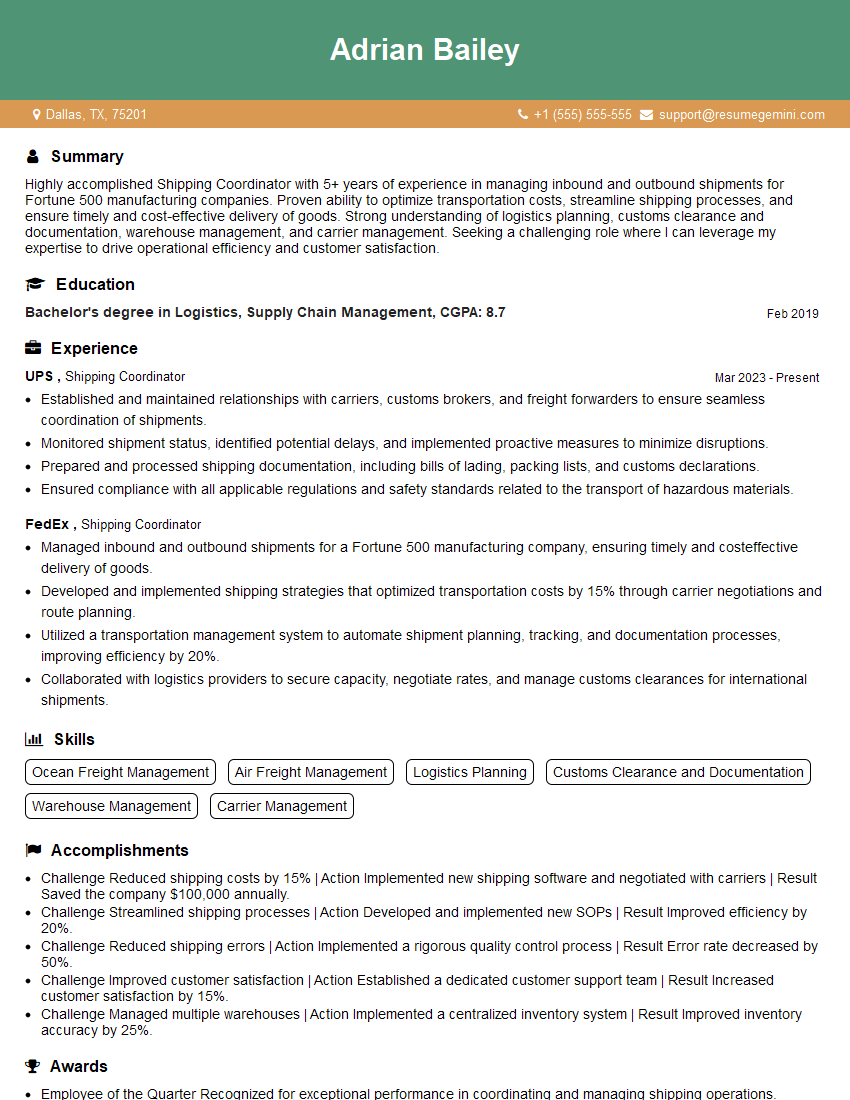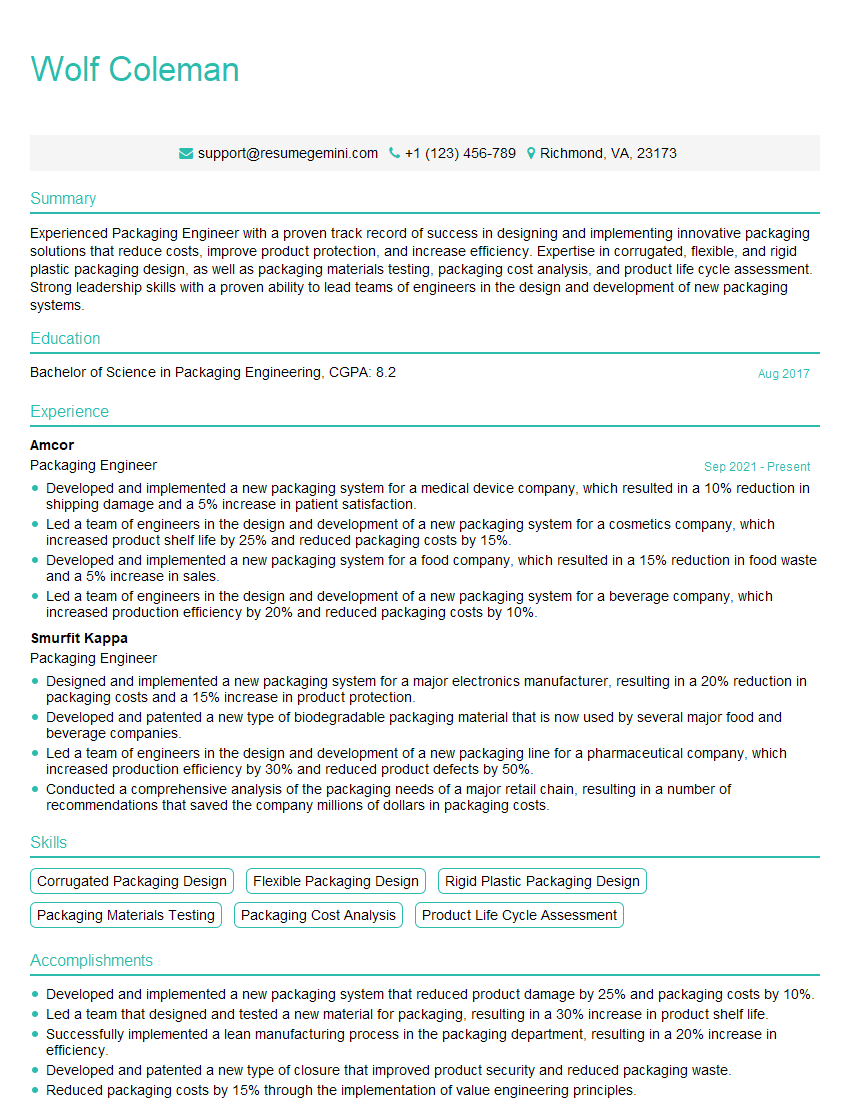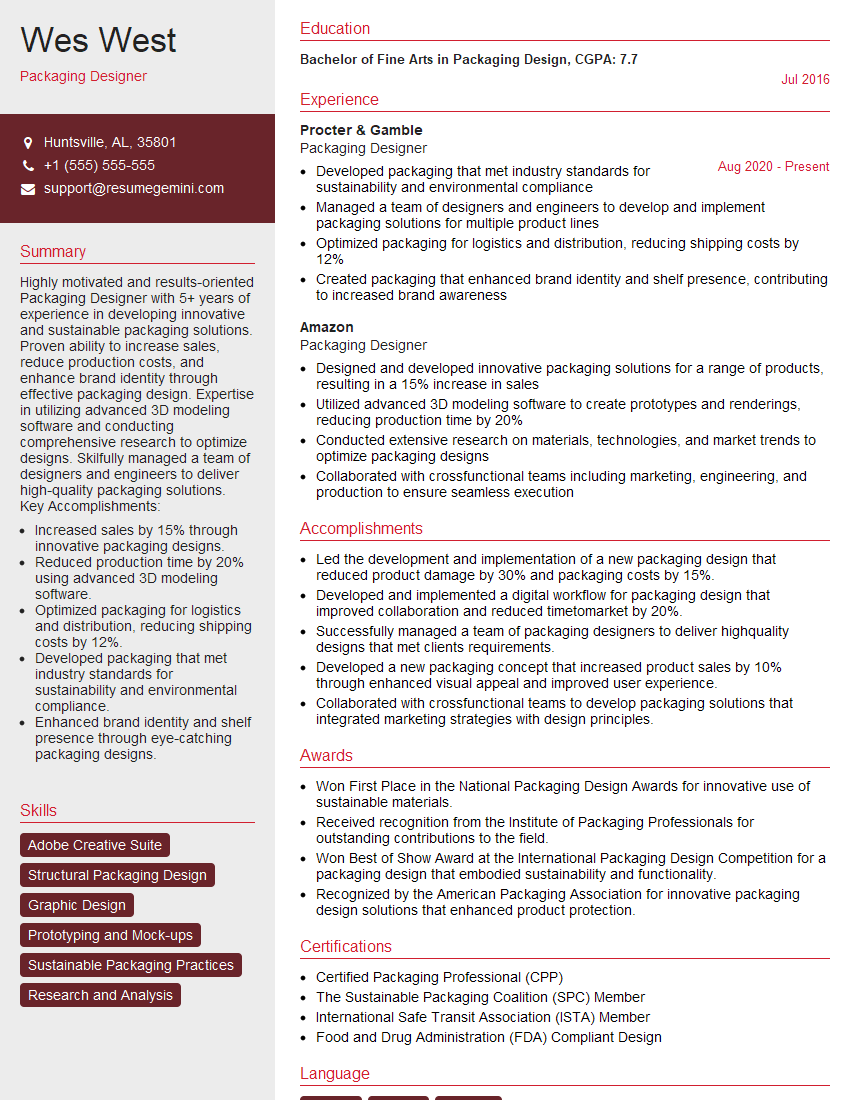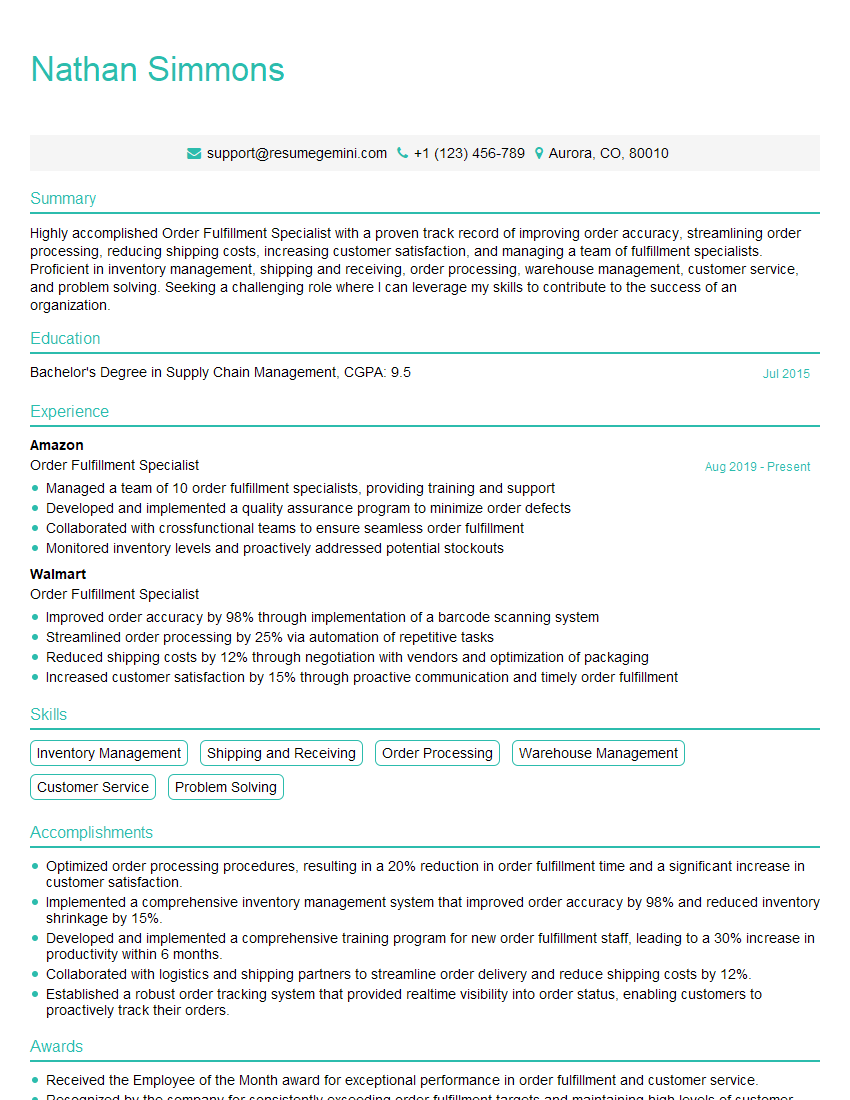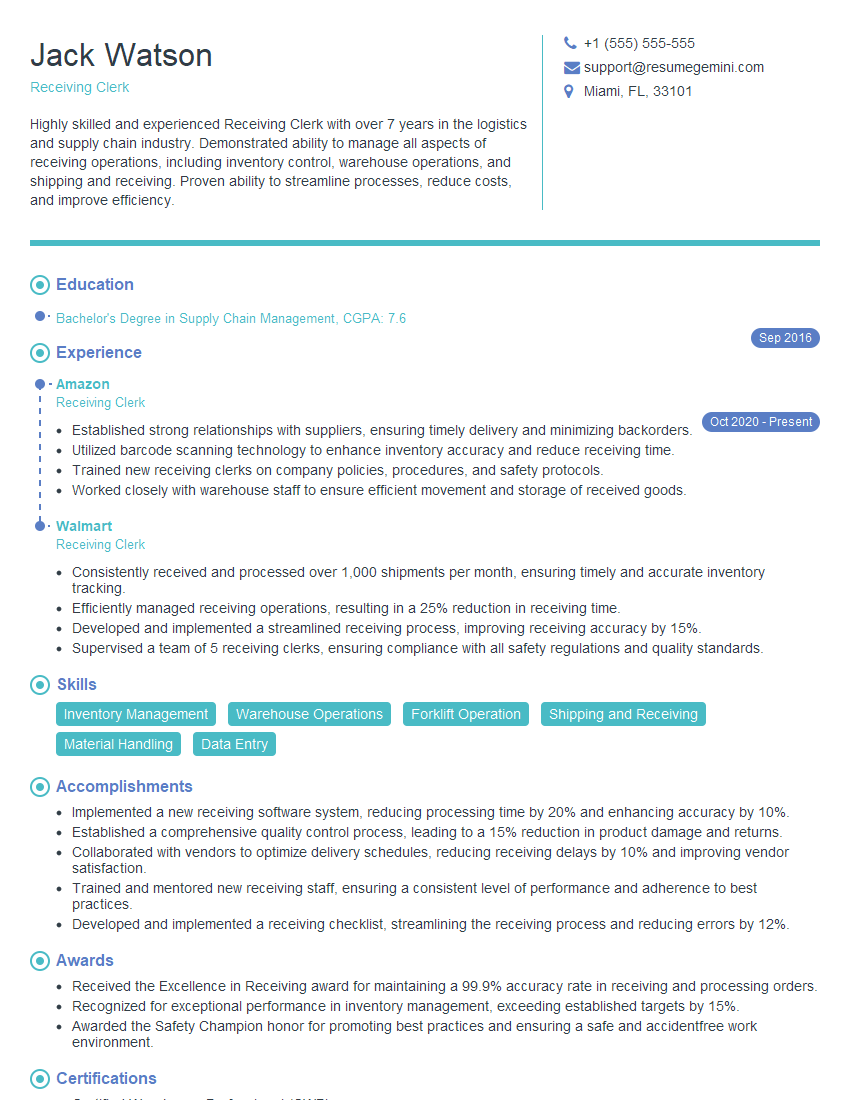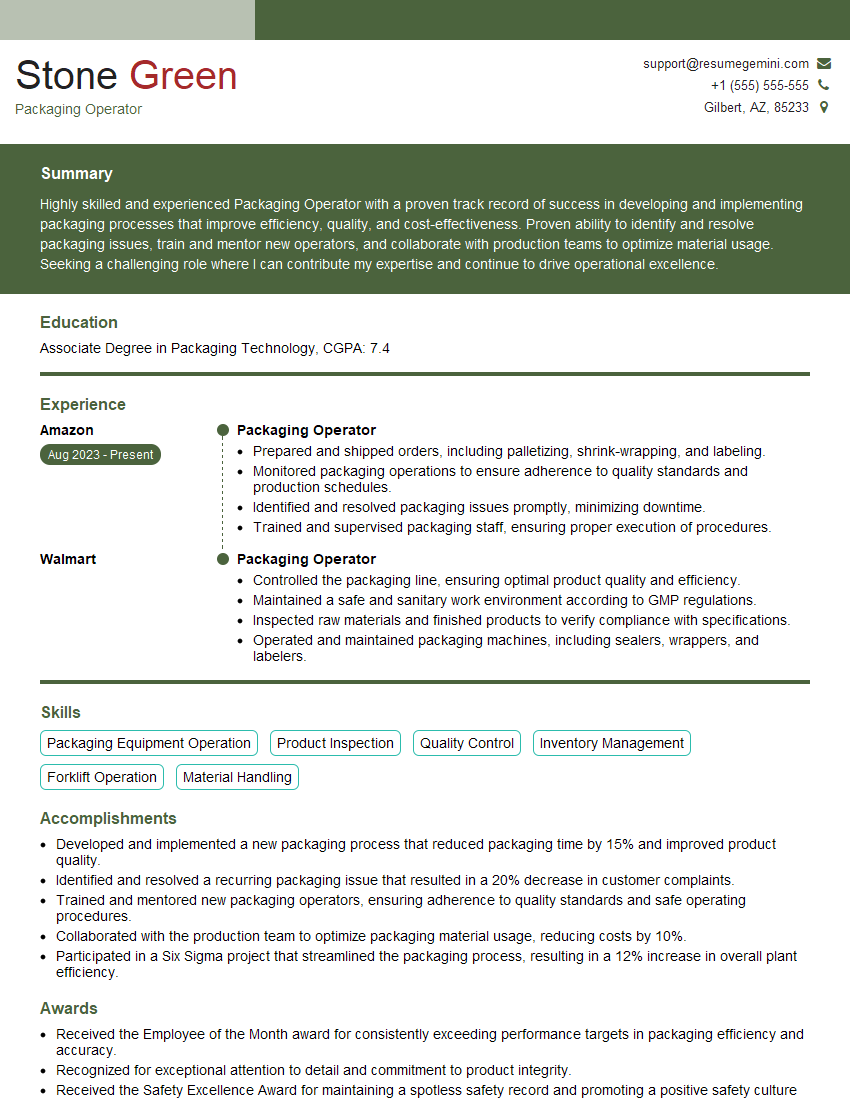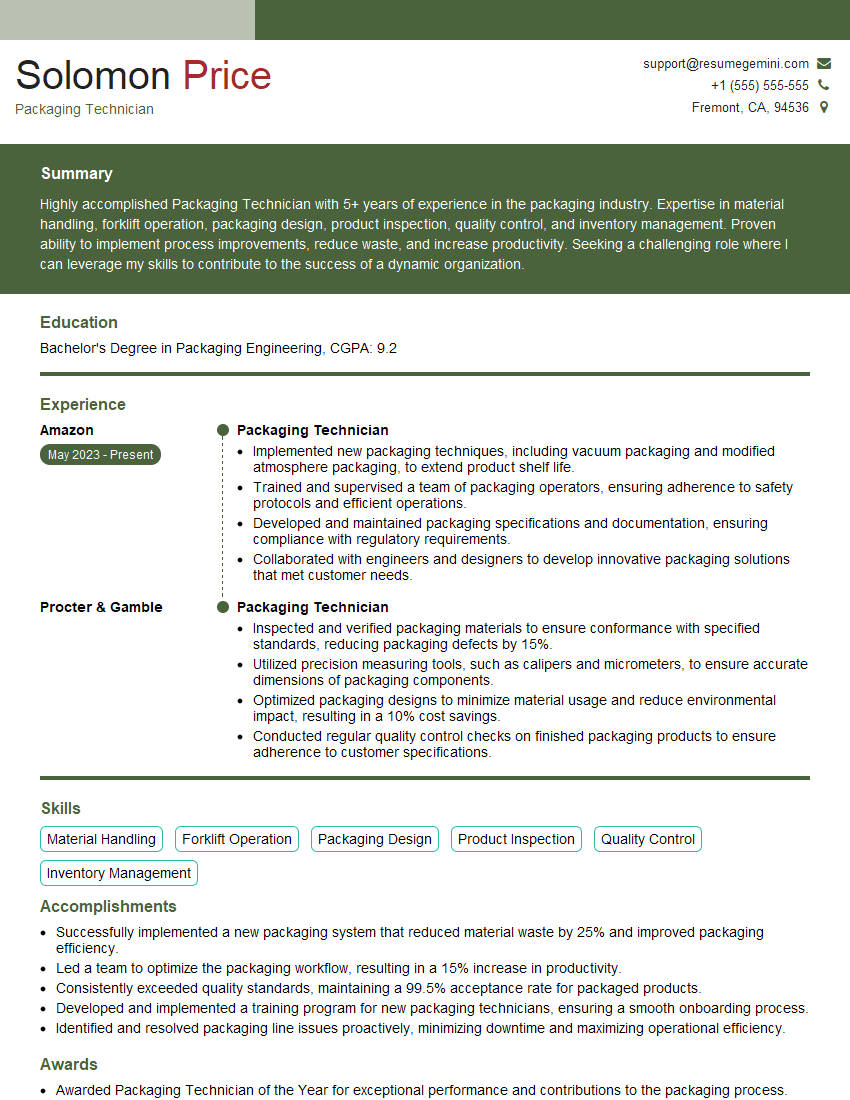Feeling uncertain about what to expect in your upcoming interview? We’ve got you covered! This blog highlights the most important Packing Supplies Knowledge interview questions and provides actionable advice to help you stand out as the ideal candidate. Let’s pave the way for your success.
Questions Asked in Packing Supplies Knowledge Interview
Q 1. What are the different types of corrugated boxes and their applications?
Corrugated boxes are ubiquitous in shipping, and their variations cater to diverse needs. The core structure involves layers of fluted cardboard sandwiched between linerboard, creating a surprisingly strong yet lightweight package. The type of flute (the wavy inner layer) significantly impacts the box’s strength and cushioning properties.
- Single-Wall: One layer of fluted cardboard. Excellent for lightweight items and where cost is a major factor. Think cereal boxes or smaller retail packages.
- Double-Wall: Two layers of fluted cardboard. Provides significantly more strength and protection, ideal for heavier or more fragile items. Often used for shipping appliances or heavier machinery components.
- Triple-Wall: Three layers of fluted cardboard. Offers the highest level of protection and strength. Primarily used for very heavy or valuable items requiring maximum protection during transit, such as industrial equipment.
- Specialty Boxes: This category encompasses boxes with additional features, like extra-strong corners, reinforced edges, or custom die-cuts to perfectly fit the product. These might include boxes designed for specific products (e.g., wine bottles) or those with added handles for ease of carrying.
Choosing the right corrugated box depends heavily on the weight, fragility, and dimensions of the product, as well as the shipping distance and handling conditions. A lighter item needing minimal protection might only need a single-wall box, while a heavy and delicate item requires a double or even triple-wall for adequate protection.
Q 2. Explain the importance of choosing the right cushioning material for fragile items.
Selecting the right cushioning material is paramount for protecting fragile items during shipping. Insufficient cushioning can lead to damage, returns, and dissatisfied customers. The choice depends on the item’s fragility, shape, and weight, as well as environmental conditions (temperature, humidity).
- Bubble Wrap: Provides good cushioning for a wide range of items. Its air pockets absorb shocks and vibrations. It’s relatively inexpensive and readily available but not the most environmentally friendly option.
- Foam peanuts: Lightweight and effective for filling void spaces, protecting items from shifting during transit. However, they can be messy and are not easily recyclable.
- Air pillows: Inflatable cushions that provide excellent protection and are more space-efficient than bubble wrap or peanuts. They are becoming increasingly popular for their sustainability and compact storage.
- Kraft paper: A natural and recyclable option; it’s often used as a protective layer or for wrapping. Offers less cushioning than other options, but it’s good for added protection against scratches.
- Custom foam inserts: Offer superior protection for oddly shaped or highly fragile items. They’re tailored to perfectly fit the product, minimizing movement and maximizing protection. This option is more expensive but justifies its cost when protecting high-value items.
Think of it like this: You wouldn’t use the same cushioning for a delicate glass vase as you would for a sturdy wooden toy. Careful consideration of the product’s vulnerabilities is essential in selecting the appropriate cushioning material.
Q 3. Describe the benefits and drawbacks of using void fill versus other packing materials.
Void fill materials are used to fill empty spaces in packaging to prevent shifting and damage during transit. They are compared to other materials like bubble wrap or foam peanuts based on their properties.
- Benefits of Void Fill: Excellent for filling irregular spaces; conforms to the product’s shape, minimizing movement. Many types are lightweight, reducing shipping costs. Some void fill options (like paper-based) are recyclable or biodegradable.
- Drawbacks of Void Fill: Can be messy, particularly loose-fill options like peanuts. Some void fills are less effective than other cushioning materials for absorbing shock. The cost can add up, especially for larger items that require extensive void fill.
Comparison to Other Materials: Compared to bubble wrap, void fill is often better at filling irregular spaces but may offer less shock absorption. Compared to custom foam inserts, void fill is generally less expensive but offers less precise protection. The best choice depends on the product’s fragility, shape, and the shipper’s budget and environmental concerns. For instance, a fragile vase might benefit from bubble wrap combined with void fill, while a less delicate item might only need void fill to prevent shifting.
Q 4. What are the key considerations for selecting appropriate packaging for international shipping?
International shipping introduces complexities that necessitate careful packaging choices. Regulations vary widely by country and courier, adding significant considerations beyond domestic shipping.
- Compliance with Regulations: Each country may have specific labeling, documentation, and material restrictions. Hazardous materials require special packaging and labeling; some materials are outright banned in certain regions.
- Durability and Protection: International shipments undergo more extensive handling and transit times. Packaging needs to withstand greater stress and potential environmental extremes (temperature fluctuations, humidity).
- Clear and Accurate Labeling: Proper labeling is crucial for customs clearance and efficient delivery. This includes accurate descriptions of contents, weight, dimensions, and origin/destination details.
- Choosing the Right Courier: Different couriers have varying capabilities and regulations. Some may specialize in handling fragile or hazardous goods.
For example, shipping electronics internationally requires robust packaging to protect against shock and moisture, along with specific labeling to comply with international regulations for hazardous materials. Failing to meet these requirements can lead to delays, fines, or even the seizure of the shipment.
Q 5. How do you determine the appropriate size of a shipping container for a given product?
Determining the appropriate shipping container size is crucial for efficient and safe shipping. Oversized containers waste space and increase costs, while undersized containers risk damaging the product.
- Measure the Product: Accurately measure the product’s length, width, and height, including any necessary packaging materials (e.g., bubble wrap, foam). Add extra space (a few inches on each side) to accommodate cushioning and prevent the item from shifting.
- Consider Product Weight: Ensure the chosen container’s weight capacity exceeds the total weight of the product and packaging. Overloading a box can compromise its structural integrity.
- Choose the Right Box Type: Select a box type (single-wall, double-wall, etc.) that provides adequate protection for the product based on its fragility and weight.
- Consider Handling: The anticipated handling during transit should influence your size decision. Rougher handling calls for a more robust container.
Imagine shipping a large, delicate vase. You wouldn’t want to use a small box that squishes the vase; nor would you want to use an excessively large one that allows the vase to shift and break. The right-sized box is crucial for safe and successful delivery.
Q 6. What are some common packaging regulations and compliance requirements?
Packaging regulations and compliance requirements are essential for ensuring safe and legal shipping practices. These vary considerably depending on the goods being shipped, the mode of transport, and the destination country.
- Hazardous Materials Regulations (DOT, IATA, IMDG): Shipping hazardous materials (e.g., flammable liquids, chemicals) requires strict adherence to regulations from agencies such as the Department of Transportation (DOT), International Air Transport Association (IATA), and International Maritime Dangerous Goods (IMDG) code. These regulations dictate packaging standards, labeling requirements, and documentation.
- Food and Drug Administration (FDA) Regulations: Packaging for food and drug products must comply with FDA regulations concerning material safety and labeling. This ensures the integrity and safety of the products.
- Environmental Regulations: Growing environmental concerns drive regulations on recyclable and biodegradable packaging materials. Some regions mandate the use of specific materials or restrict certain types of packaging.
- Customs Regulations: International shipments need to comply with customs regulations regarding labeling, documentation, and declaration of contents. Failure to comply can lead to delays, fines, and shipment rejection.
Ignoring these regulations can result in significant penalties, shipping delays, and reputational damage. Understanding and complying with relevant regulations is crucial for successful and responsible shipping practices.
Q 7. What are the different types of sealing methods for packaging?
Various sealing methods ensure package integrity during transit, protecting contents and preventing tampering. The optimal method depends on the packaging material and contents.
- Taping: Commonly used with corrugated boxes. Using appropriate tape (e.g., water-activated tape for strong seals) and applying it correctly is crucial. The strength and width of the tape influence the seal’s durability.
- Stapling: A quick and cost-effective method for some types of packaging but not suitable for all materials. Staples can damage certain products or provide insufficient security for high-value items.
- Heat Sealing: Used for plastic bags, pouches, and some types of flexible packaging. Provides a strong, tamper-evident seal. Specialized equipment is required.
- Glue or Adhesive: Can be used for various packaging materials but requires careful application to ensure a strong and reliable seal. Some adhesives are not suitable for all materials.
- Crimping: Used for metal containers, tubes, and some types of plastic packaging. Creates a secure, tamper-evident seal, often mechanically assisted.
The choice of sealing method needs to consider the packaging material, product type, shipping environment, and desired level of security. A poorly sealed package is vulnerable to damage, loss, or tampering. Choosing the right method for the job is a key factor in successful shipping operations.
Q 8. How do you ensure the integrity of packaging during transit?
Ensuring packaging integrity during transit is crucial for preventing damage and loss. It’s like building a fortress around your product to protect it from the rigors of shipping. This involves a multi-layered approach:
- Proper Material Selection: Choosing the right materials – corrugated cardboard, foam inserts, protective films – is paramount. The strength and cushioning properties of the material must match the product’s fragility and the anticipated transit conditions. For example, fragile electronics require more robust packaging than a sturdy piece of furniture.
- Effective Product Protection: This includes using appropriate cushioning materials (e.g., bubble wrap, air pillows, peanuts) to absorb shocks and vibrations. Products should be snugly secured within the packaging to prevent shifting during transit. Think of it like wrapping a gift – you wouldn’t just throw it in a box, right?
- Secure Closure and Sealing: The packaging must be securely closed and sealed to prevent tampering and product damage. Using strong tape, reinforced corners, and appropriate closures is essential. This keeps everything intact and prevents accidental openings.
- Appropriate Packaging Size: The packaging should be appropriately sized to fit the product snugly, minimizing movement during transit. Oversized packaging can lead to damage due to shifting. On the other hand, excessively tight packaging could damage the product itself.
- Clear and Comprehensive Labeling: Clear and visible labeling indicating fragile contents, handling instructions, and proper orientation helps ensure the product is handled with care throughout the shipping process. This is like having clear instructions for someone to follow.
Q 9. Explain the concept of ‘cube utilization’ in packaging and warehousing.
Cube utilization refers to maximizing the space within a shipping container, warehouse, or storage unit. Think of it like a Tetris game – you want to fit as many products as possible without wasting space. Efficient cube utilization translates to significant cost savings in transportation and warehousing.
It’s achieved through several strategies:
- Optimized Packaging Design: Designing packaging that fits snugly together minimizes empty space and allows for greater efficiency in packing. This could involve using custom-sized boxes or employing innovative packaging designs.
- Proper Pallet Loading: Strategic placement of products and boxes on pallets is crucial. Efficient stacking and load planning ensure maximum space utilization and prevent instability during transport.
- Warehouse Layout: Effective warehouse layout and organization are critical. Proper shelving, aisle widths, and storage solutions optimize space and ease of access to inventory.
- Software and Technology: Warehouse management systems (WMS) can help optimize cube utilization by providing data-driven insights into space optimization strategies.
For example, a company shipping books might switch from large, empty boxes to smaller, denser packaging, resulting in significant cost savings on shipping.
Q 10. What are the environmental considerations when selecting packaging materials?
Environmental considerations are increasingly crucial when selecting packaging materials. We need to minimize our environmental impact while still ensuring product protection. This involves considering:
- Recycled Content: Prioritizing packaging made from recycled materials reduces the demand for virgin resources. Look for packaging with high post-consumer recycled (PCR) content.
- Recyclability: Choosing materials that are easily recyclable minimizes waste ending up in landfills. Clear labeling about recyclability is important.
- Biodegradability and Compostability: Opting for biodegradable or compostable materials offers an eco-friendly alternative for certain applications, especially for packaging that’s not easily recycled.
- Reduced Material Use: Using lighter-weight materials or optimizing packaging design to minimize material usage reduces the overall environmental footprint.
- Sustainable Sourcing: Ensuring materials are sourced from sustainably managed forests or other responsible sources is also important.
For instance, switching from polystyrene peanuts to biodegradable packing peanuts or using recycled cardboard boxes are steps towards eco-friendlier packaging.
Q 11. How do you handle damaged packaging in a warehouse setting?
Handling damaged packaging in a warehouse requires a systematic approach to minimize further damage and potential product loss. Here’s a process I’d follow:
- Assessment and Documentation: Thoroughly inspect the damaged packaging, noting the extent of the damage and any potential impact on the product inside. Document the damage with photos and detailed descriptions.
- Product Inspection: Carefully inspect the product inside to assess whether it has been affected by the damaged packaging. Note any damage to the product as well.
- Segregation and Storage: Separate damaged packaging from undamaged inventory. Store damaged goods in a designated area to prevent further deterioration or accidental damage.
- Damage Reporting: Report the damage to relevant personnel, including logistics and quality control teams, using established internal processes.
- Disposal or Repair: Decide whether the packaging can be repaired or if it needs to be disposed of according to company procedures and environmental regulations. This might involve recycling or waste disposal based on the material type.
- Root Cause Analysis: Investigate the root cause of the damage to prevent similar incidents in the future. This could involve reviewing handling procedures, storage conditions, or the packaging design itself.
Q 12. What are the key performance indicators (KPIs) for effective packing and shipping?
Key performance indicators (KPIs) for effective packing and shipping provide insights into efficiency and effectiveness. Some crucial KPIs include:
- On-Time Shipping Rate: Measures the percentage of shipments delivered on or before the scheduled delivery date. This indicates the efficiency of the overall packing and shipping process.
- Order Fulfillment Rate: Shows the percentage of orders that have been successfully packed and shipped. High rates indicate efficient order processing.
- Damage Rate: Tracks the percentage of shipments arriving with damage. Low rates signify effective packaging and handling.
- Packaging Costs per Unit: Measures the cost of packaging materials per shipped unit. This helps optimize packaging material selection and usage.
- Inventory Turnover Rate: Reflects how efficiently inventory moves through the packing and shipping process. High rates suggest efficient warehouse management.
- Customer Satisfaction: While not directly related to packing, customer satisfaction with the delivery experience and product condition reflects the overall success of the packing and shipping process.
Q 13. Describe your experience with different types of labeling systems.
My experience encompasses various labeling systems, from simple manual label application to fully automated systems. I’ve worked with:
- Hand-applied labels: These are cost-effective for low-volume operations but can be time-consuming and prone to inconsistencies.
- Thermal Transfer Printers: These printers create highly durable and legible labels, ideal for various environments. They are suitable for medium to high-volume operations.
- Direct Thermal Printers: These are faster and cheaper than thermal transfer printers but the labels are not as durable and may fade over time.
- Barcode and RFID labeling: These systems enable efficient inventory tracking and management. Barcodes are widely used and relatively inexpensive, while RFID offers greater tracking capabilities but is typically more expensive.
- Integrated labeling systems: These systems automate the labeling process, connecting directly to warehouse management systems (WMS) and ERP systems for streamlined data transfer and reduced errors.
I understand the importance of choosing the right labeling system based on the volume, complexity, and specific requirements of the operation.
Q 14. What is your experience with inventory management systems related to packing supplies?
My experience with inventory management systems related to packing supplies involves utilizing software solutions to track stock levels, monitor usage, and manage reordering processes. I’m familiar with systems that:
- Track inventory levels: These systems provide real-time visibility into stock levels of various packing materials, alerting us to low stock situations before they impact operations.
- Manage reordering: Automated reordering systems trigger purchase orders when inventory reaches pre-defined thresholds, optimizing stock levels and minimizing stockouts.
- Analyze consumption data: Sophisticated systems can analyze historical consumption data to predict future demand and optimize inventory levels, minimizing waste and storage costs.
- Integrate with other systems: Effective systems integrate with warehouse management systems (WMS), enterprise resource planning (ERP) systems, and purchasing systems for seamless data flow.
In one role, I implemented a new inventory management system that reduced our packing supply costs by 15% by optimizing stock levels and negotiating better pricing with suppliers due to improved forecasting capabilities. This shows the direct link between effective inventory management and cost savings.
Q 15. How do you handle packaging waste in an environmentally responsible way?
Environmentally responsible waste handling in packaging starts with a commitment to reducing, reusing, and recycling. We prioritize using recycled content in our packaging materials whenever possible, opting for products with high recycled percentages and certifications like FSC (Forest Stewardship Council) for sustainably sourced paper-based materials.
Beyond material selection, we implement robust waste segregation programs. This involves clearly labeling bins for different waste streams – paper, cardboard, plastic, etc. – to ensure accurate sorting and efficient recycling. We partner with certified recycling facilities and regularly audit their processes to guarantee proper waste management. For materials not easily recyclable, we explore options like composting (for biodegradable materials) or energy recovery (where appropriate and environmentally sound). We also carefully monitor waste generation, tracking volumes and types of waste to identify areas for improvement and set reduction targets. For example, optimizing packaging design to minimize materials used is a key strategy. This might involve switching to more efficient box sizes or using void fill alternatives like recycled paper peanuts instead of polystyrene.
Career Expert Tips:
- Ace those interviews! Prepare effectively by reviewing the Top 50 Most Common Interview Questions on ResumeGemini.
- Navigate your job search with confidence! Explore a wide range of Career Tips on ResumeGemini. Learn about common challenges and recommendations to overcome them.
- Craft the perfect resume! Master the Art of Resume Writing with ResumeGemini’s guide. Showcase your unique qualifications and achievements effectively.
- Don’t miss out on holiday savings! Build your dream resume with ResumeGemini’s ATS optimized templates.
Q 16. What are the different types of stretch film and their applications?
Stretch film is a crucial packaging material offering exceptional product protection and palletizing stability. Several types exist, each with specific applications:
- Standard Stretch Film: This is the most common type, offering a good balance of cost and performance. It’s suitable for a wide range of palletized goods requiring moderate protection.
- Cast Stretch Film: Known for its superior clarity, high tensile strength, and thinner gauge, cast film reduces overall film usage, offering cost savings in the long run. Its clarity is advantageous for visual inspection of the palletized goods.
- Machine Stretch Film: Designed for high-speed automated packaging lines, it’s generally more robust and can handle faster wrapping speeds. It’s essential for large-scale operations prioritizing efficiency.
- Pre-Stretch Film: This film is pre-stretched during the manufacturing process, requiring less stretching during application, thereby saving time and film. It’s also often more durable.
- Colored Stretch Film: While less common, colored stretch film (e.g., black) is used for light-sensitive products or to enhance brand visibility.
The choice of stretch film depends on factors like product type, palletizing speed, required protection level, and budget. For example, fragile electronics might require cast stretch film for its superior clarity and strength, whereas a less sensitive product might be adequately protected by standard stretch film.
Q 17. How do you calculate the cost-effectiveness of different packaging solutions?
Cost-effectiveness in packaging involves considering all related expenses throughout the packaging lifecycle, not just the initial material cost. We employ a Total Cost of Ownership (TCO) analysis to evaluate various options.
This approach considers factors such as:
- Material costs: Price per unit of packaging material.
- Labor costs: Time spent on packaging and handling.
- Equipment costs: Initial investment and maintenance of packaging machinery.
- Transportation costs: Increased weight or volume may impact shipping charges.
- Waste disposal costs: Recycling or disposal fees for packaging waste.
- Damage costs: Losses from product damage during transit due to inadequate packaging.
By calculating the TCO for each packaging solution, we can make informed decisions. For instance, a slightly more expensive material might reduce damage rates, ultimately saving money in the long run. We often use spreadsheets or dedicated software to model these costs, facilitating comparison between different packaging scenarios.
Q 18. Describe your experience with automated packaging equipment.
I have extensive experience with various automated packaging equipment, including robotic palletizers, automated stretch wrappers, case erectors, and taping machines. My experience encompasses both the implementation and operational aspects of these systems.
In a previous role, I oversaw the installation and commissioning of a new robotic palletizing system. This involved collaborating with engineers, programmers, and operators to ensure seamless integration into our existing warehouse infrastructure. We meticulously mapped out workflow, programming the robot to handle different product sizes and configurations while minimizing downtime and optimizing pallet layouts. We also implemented a comprehensive training program for operators to ensure safe and efficient use of the automated equipment.
Beyond robotic systems, I’m also proficient in troubleshooting and maintenance of various automated machines. My experience spans equipment from different manufacturers, requiring adaptability and a solid understanding of mechanical and electrical principles.
Q 19. What safety procedures do you follow when handling packing supplies?
Safety is paramount when handling packing supplies. Our procedures emphasize hazard identification and risk mitigation.
- Personal Protective Equipment (PPE): We mandate the use of appropriate PPE, including gloves (to protect against cuts and chemical exposure), safety glasses (to prevent eye injuries from flying debris), and sturdy footwear (to prevent foot injuries from dropped objects).
- Safe Lifting Techniques: Training is provided on proper lifting techniques to prevent back injuries, particularly when handling heavy boxes or rolls of packaging materials.
- Machine Safety: Strict adherence to lockout/tagout procedures is followed during machine maintenance and repair. Operators receive thorough training on safe operating procedures for all automated equipment.
- Chemical Safety: SDS (Safety Data Sheets) are readily available for all chemicals, and proper handling and storage procedures are followed to minimize the risks of exposure. Adequate ventilation is crucial in areas where solvents or adhesives are used.
- Housekeeping: Maintaining a clean and organized work environment is critical. Spills are cleaned up immediately, and obstacles are removed to prevent slips, trips, and falls.
Regular safety audits and training sessions ensure that all employees are aware of and follow established safety protocols. We actively encourage a safety-first culture and empower employees to report any unsafe conditions or practices.
Q 20. Explain the importance of proper palletizing techniques.
Proper palletizing techniques are critical for efficient warehousing, transportation, and ultimately, product safety. Improper palletizing can lead to instability, damage, and increased costs.
Key aspects include:
- Weight Distribution: Heavy items should be placed at the bottom of the pallet, with progressively lighter items stacked on top. Weight should be evenly distributed to avoid creating unbalanced loads.
- Product Orientation: Products should be oriented to maximize stability and minimize shifting during transit. This might involve using dividers or separators for irregularly shaped items.
- Layer Patterns: Consistent layer patterns (e.g., bricklaying pattern) create stability and prevent gaps.
- Stretch Wrapping: Appropriate stretch wrapping secures the load, preventing shifting and damage during transportation.
- Pallet Type: Selecting the correct pallet type (e.g., wood, plastic) based on the load weight and type is crucial.
- Stacking Height: Adhering to recommended stacking heights prevents instability and potential collapse.
Following these principles minimizes the risk of product damage, reduces transportation costs (due to optimized space utilization), and enhances overall warehouse efficiency. For instance, if you are shipping fragile glass items, extra care is needed in layer patterns, and possibly the use of additional cushioning materials in addition to stretch wrapping. Conversely, stacking heavy sacks of grain may involve different considerations related to weight distribution and potential compression.
Q 21. How do you address packaging design challenges to protect products effectively?
Packaging design challenges often involve balancing protection with cost-effectiveness and sustainability. Addressing these challenges involves a systematic approach:
- Product Analysis: Thoroughly understanding the product’s fragility, dimensions, and environmental sensitivities (e.g., temperature, humidity) is the starting point.
- Material Selection: Choosing the right materials based on product characteristics and environmental factors is crucial. This might involve considering cushioning materials (e.g., foam, air pillows, paper), protective liners, and outer packaging (e.g., corrugated cardboard, plastic containers).
- Design Optimization: Utilizing design software and engineering principles to optimize the packaging structure is crucial for maximizing protection while minimizing material use. This often involves stress analysis to ensure the package can withstand the rigors of handling and shipping.
- Testing and Validation: Rigorous testing (e.g., vibration testing, drop tests) under simulated shipping conditions is essential to validate the effectiveness of the packaging design. This helps identify potential weaknesses and refine the design.
- Sustainability Considerations: Choosing recyclable or biodegradable materials, minimizing packaging volume, and optimizing logistics to reduce transportation emissions are vital elements of sustainable packaging design.
For instance, designing packaging for a delicate electronic device might involve using custom-fit foam inserts within a corrugated box, followed by robust stretch wrapping, while designing packaging for a sturdy metal component might require a more minimalist approach emphasizing material efficiency.
Q 22. What is your experience with various types of tape and their applications?
My experience with various tapes spans over a decade, encompassing diverse applications across various industries. Understanding the nuances of each type is crucial for optimal packaging. For instance, water-activated tape, often made from paper and a water-soluble adhesive, offers excellent strength and is ideal for heavier boxes requiring secure closure and archival strength. It’s environmentally friendly as well. Conversely, pressure-sensitive tapes, like polypropylene or vinyl tapes, offer quick and easy application, perfect for lighter packages and quick sealing, but might not be as strong for heavy or fragile goods.
- Paper Tape: Eco-friendly, biodegradable, and offers good adhesion, ideal for lighter items and eco-conscious packaging.
- Polypropylene Tape: Strong, versatile, and water-resistant. A good all-around choice for many shipping applications.
- Vinyl Tape: Offers excellent tensile strength and resistance to moisture and tears, suited for heavier packages or those exposed to harsh conditions.
- Filament Tape: Extremely high tensile strength, used for securing heavy or oddly-shaped items, crucial in industrial packaging.
Choosing the right tape isn’t just about cost; it’s about ensuring the integrity of the package and preventing damage during transit. For example, using paper tape on a heavy box destined for long-distance shipping is a recipe for disaster; the seams will likely burst open.
Q 23. How do you ensure efficient stock rotation of packing supplies?
Efficient stock rotation is paramount to avoid product degradation and minimize waste. We employ a FIFO (First-In, First-Out) system, carefully tracking the arrival dates and expiration dates (where applicable) of all our packing supplies. This is often aided by barcoding and dedicated inventory management software.
Our warehouse is organized according to a zone system. New stock is added to the designated zone, pushing older stock towards the packing stations. Regular inventory checks and cycle counting prevent discrepancies. We also monitor consumption rates closely; this data guides our reordering strategy, preventing overstocking and ensuring we always have enough of the items most in demand.
Imagine a bakery: they wouldn’t use day-old bread before fresh bread, right? Similarly, we prioritize older packing supplies to prevent expiry or degradation and ensure our clients always receive top-quality packaging materials.
Q 24. Describe your process for evaluating the quality of packing supplies.
Evaluating the quality of packing supplies involves a multi-faceted approach, encompassing both physical and performance testing. We start with visual inspection – checking for defects like tears, punctures, and inconsistencies in material thickness. Next, we conduct strength tests. This could involve measuring the tensile strength of tape or the burst strength of boxes. We also assess the water resistance of materials by subjecting them to controlled moisture conditions. For cushioning materials, we evaluate their shock absorption capacity.
Beyond physical attributes, we look at the supplier’s reputation, certifications, and compliance with industry standards. We regularly sample shipments to ensure consistent quality. If we find a defect rate exceeding our tolerance, we initiate a quality control review with the supplier.
It’s like buying a car – you wouldn’t just trust a sales pitch; you’d look at the car’s condition, test drive it, and possibly get a mechanic’s opinion. Similarly, we rigorously test and verify the quality of our packing supplies before adding them to our inventory.
Q 25. What are the key factors to consider when designing packaging for e-commerce?
Designing e-commerce packaging requires a delicate balance between protection, cost-effectiveness, and brand appeal. Key factors include:
- Product Protection: The primary goal. This dictates the choice of materials (corrugated boxes, bubble wrap, etc.) and the design of inserts to prevent damage during transit. Fragile items require specialized cushioning.
- Size and Weight Optimization: Minimize dimensions to reduce shipping costs while ensuring enough space for protective materials. Efficient packing reduces dimensional weight charges from carriers.
- Sustainability: Using eco-friendly materials (recycled cardboard, biodegradable fillers) is increasingly important. Consumers are more environmentally conscious.
- Branding: The packaging itself can be a marketing tool. Custom boxes, printed tape, or inserts with logos and messaging reinforce brand identity.
- Ease of Opening: Frustration-free packaging is a significant factor. Easy-to-open boxes improve the customer experience.
- Compliance with Shipping Regulations: Adhering to carrier-specific guidelines for size, weight, and labeling is vital to avoid delays or returns.
For example, a delicate ceramic vase requires a much sturdier box and more robust cushioning than a t-shirt. Careful consideration of these factors will make or break an e-commerce shipping strategy.
Q 26. How do you handle packaging returns and recalls?
Handling packaging returns and recalls requires a structured approach. First, we investigate the reason for return. Is it due to damage during transit, a packaging defect, or another reason? This helps determine corrective action.
For returns, we have a clearly defined process for inspecting the returned packaging. Data on the cause of the return is meticulously documented, which helps in identifying systemic issues (faulty materials, poor design, etc.). For recalls, we immediately initiate a comprehensive stop-ship order and work with the supplier to address the root cause. We then notify our clients and offer replacement packaging or refunds as necessary. Transparency and swift action are crucial during a recall.
Think of a car manufacturer recalling a faulty part. The same principle applies here; prompt action minimizes damage and maintains client trust.
Q 27. Explain your experience with various types of dunnage and bracing materials.
My experience encompasses various dunnage and bracing materials, crucial for securing goods during transit and preventing damage. Dunnage, in its simplest form, is protective packaging that fills empty spaces. Bracing materials reinforce and support the structure of the package.
- Inflatable Dunnage: Customizable air-filled bags conform to the shape of the product, providing excellent shock absorption.
- Foam Dunnage: Sheets, rolls, or custom-cut pieces offering protection from impacts and vibration. Different densities cater to varying needs.
- Void Fill: Materials like peanuts, air pillows, or shredded paper fill empty spaces within boxes, preventing items from shifting.
- Wood Bracing: For heavier goods, wooden supports reinforce the package and prevent shifting during transport.
- Corrugated Cardboard Dividers: Provide separation and protection between items within a box, especially for fragile goods.
The choice of dunnage and bracing depends on the product’s fragility, weight, and the shipment’s environment. For instance, transporting delicate electronics requires a different approach than shipping heavy machinery; the former calls for ample cushioning and careful bracing, while the latter might require robust wood supports.
Key Topics to Learn for Packing Supplies Knowledge Interview
- Types of Packaging Materials: Understanding the properties and applications of various materials like cardboard, corrugated fiberboard, plastics, foams, and cushioning agents. Consider their strengths, weaknesses, and suitability for different products and shipping conditions.
- Packaging Design Principles: Learn about designing effective packaging that protects the product during transit, prevents damage, and complies with industry regulations. This includes understanding concepts like shock absorption, vibration dampening, and moisture protection.
- Sustainable Packaging Practices: Familiarize yourself with eco-friendly packaging options and the growing importance of reducing waste and environmental impact in the supply chain. Explore biodegradable materials, recyclable packaging, and efficient packaging designs.
- Packaging Regulations and Compliance: Understand relevant safety regulations, labeling requirements, and international shipping standards. This includes hazardous materials handling and proper documentation.
- Inventory Management and Procurement: Learn about optimizing packaging material inventory levels, sourcing reliable suppliers, and managing costs effectively. This also includes understanding supply chain dynamics and potential disruptions.
- Cost-Effective Packaging Solutions: Explore strategies for minimizing packaging costs without compromising product protection. This includes understanding different packaging configurations and optimizing material usage.
- Automation and Technology in Packaging: Familiarize yourself with automated packaging systems, including machinery, software, and technologies used to improve efficiency and reduce labor costs. This could involve understanding robotic palletizing or automated case sealing.
Next Steps
Mastering Packing Supplies Knowledge is crucial for career advancement in logistics, supply chain management, and manufacturing. A strong understanding of these concepts demonstrates your value and expertise, leading to better opportunities and higher earning potential. To maximize your job prospects, create an ATS-friendly resume that showcases your skills and experience effectively. ResumeGemini is a trusted resource that can help you build a professional and impactful resume. We provide examples of resumes tailored to Packing Supplies Knowledge to guide you in creating your own.
Explore more articles
Users Rating of Our Blogs
Share Your Experience
We value your feedback! Please rate our content and share your thoughts (optional).
What Readers Say About Our Blog
Hello,
We found issues with your domain’s email setup that may be sending your messages to spam or blocking them completely. InboxShield Mini shows you how to fix it in minutes — no tech skills required.
Scan your domain now for details: https://inboxshield-mini.com/
— Adam @ InboxShield Mini
Reply STOP to unsubscribe
Hi, are you owner of interviewgemini.com? What if I told you I could help you find extra time in your schedule, reconnect with leads you didn’t even realize you missed, and bring in more “I want to work with you” conversations, without increasing your ad spend or hiring a full-time employee?
All with a flexible, budget-friendly service that could easily pay for itself. Sounds good?
Would it be nice to jump on a quick 10-minute call so I can show you exactly how we make this work?
Best,
Hapei
Marketing Director
Hey, I know you’re the owner of interviewgemini.com. I’ll be quick.
Fundraising for your business is tough and time-consuming. We make it easier by guaranteeing two private investor meetings each month, for six months. No demos, no pitch events – just direct introductions to active investors matched to your startup.
If youR17;re raising, this could help you build real momentum. Want me to send more info?
Hi, I represent an SEO company that specialises in getting you AI citations and higher rankings on Google. I’d like to offer you a 100% free SEO audit for your website. Would you be interested?
Hi, I represent an SEO company that specialises in getting you AI citations and higher rankings on Google. I’d like to offer you a 100% free SEO audit for your website. Would you be interested?
good





